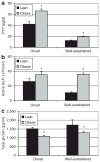Differential secretion of satiety hormones with progression of obesity in JCR:LA-corpulent rats
- PMID: 18239578
- PMCID: PMC3827016
- DOI: 10.1038/oby.2007.128
Differential secretion of satiety hormones with progression of obesity in JCR:LA-corpulent rats
Abstract
Objective: To characterize the gastrointestinal tract at the onset and in well-established obesity.
Methods and procedures: Lean (+/?) and obese (cp/cp) male JCR:LA-cp rats lacking a functional leptin receptor were killed at 3.5 weeks and 9 months of age and plasma concentrations of satiety hormones determined. The small intestine, colon, and stomach were measured, weighed, and mRNA levels of satiety genes quantified.
Results: At the onset of obesity, obese rats had greater intestine, colon, and liver mass when adjusted for body weight compared to lean rats. Conversely, adult rats with established obesity had lower intestine and colon mass and length after adjustment for body weight. Early changes in gene expression included decreased ghrelin mRNA levels in stomach and increased peptide YY (PYY) mRNA levels in duodenum of young obese rats. After massive accumulation of adipose tissue had occurred, adult obese rats had increased proglucagon and ghrelin mRNA expression in the proximal intestine. In the distal small intestine, obese rats had lower proglucagon, ghrelin, and PYY mRNA levels. Finally, at the onset and in well-established obesity, obese rats had higher plasma insulin, amylin, glucagon like peptide-1 (GLP-1), and PYY, a finding, with the exception of insulin, unique to this model. Plasma total ghrelin levels were significantly lower at the onset of obesity and established obesity compared to the lean rats.
Discussion: Several defects are manifested in the obese gut early on in the disease before the accumulation of large excesses of body fat and represent potential targets for early intervention in obesity.
Conflict of interest statement
The authors declared no conflict of interest.
Figures



References
-
- Anderson JW, Konz EC, Frederich RC, Wood CL. Long-term weight loss maintenance: a meta-analysis of US studies. Am J Clin Nutr. 2001;74:579–584. - PubMed
-
- Larsen PJ, Vrang N, Tang-Christensen M. Central pre-proglucagon derived peptides: opportunities for treatment of obesity. Curr Pharm Des. 2003;9:1373–1382. - PubMed
-
- Huda MSB, Wilding JPH, Pinkney JH. Gut peptides and the regulation of appetite. Obes Rev. 2006;7:163–182. - PubMed
-
- Drucker DJ. The biology of incretin hormones. Cell Metab. 2006;3:153–165. - PubMed
-
- Dhanvantari S, Izzo A, Jansen E, Brubaker PL. Coregulation of glucagon-like peptide-1 synthesis with proglucagon and prohormone convertase 1 gene expression in enteroendocrine GLUTag cells. Endocrinology. 2001;142:37–42. - PubMed
Publication types
MeSH terms
Substances
Grants and funding
LinkOut - more resources
Full Text Sources
Medical
Miscellaneous

